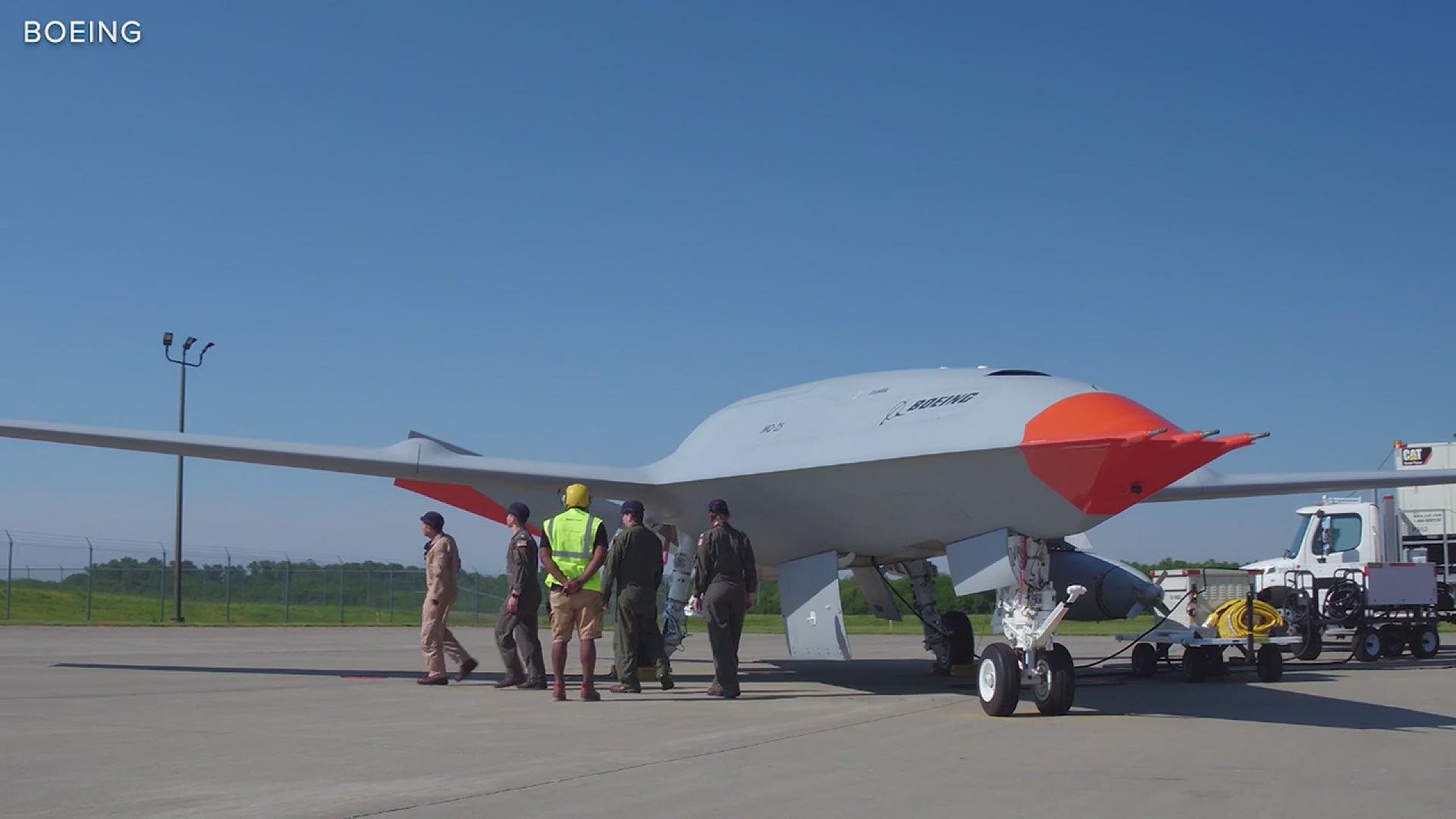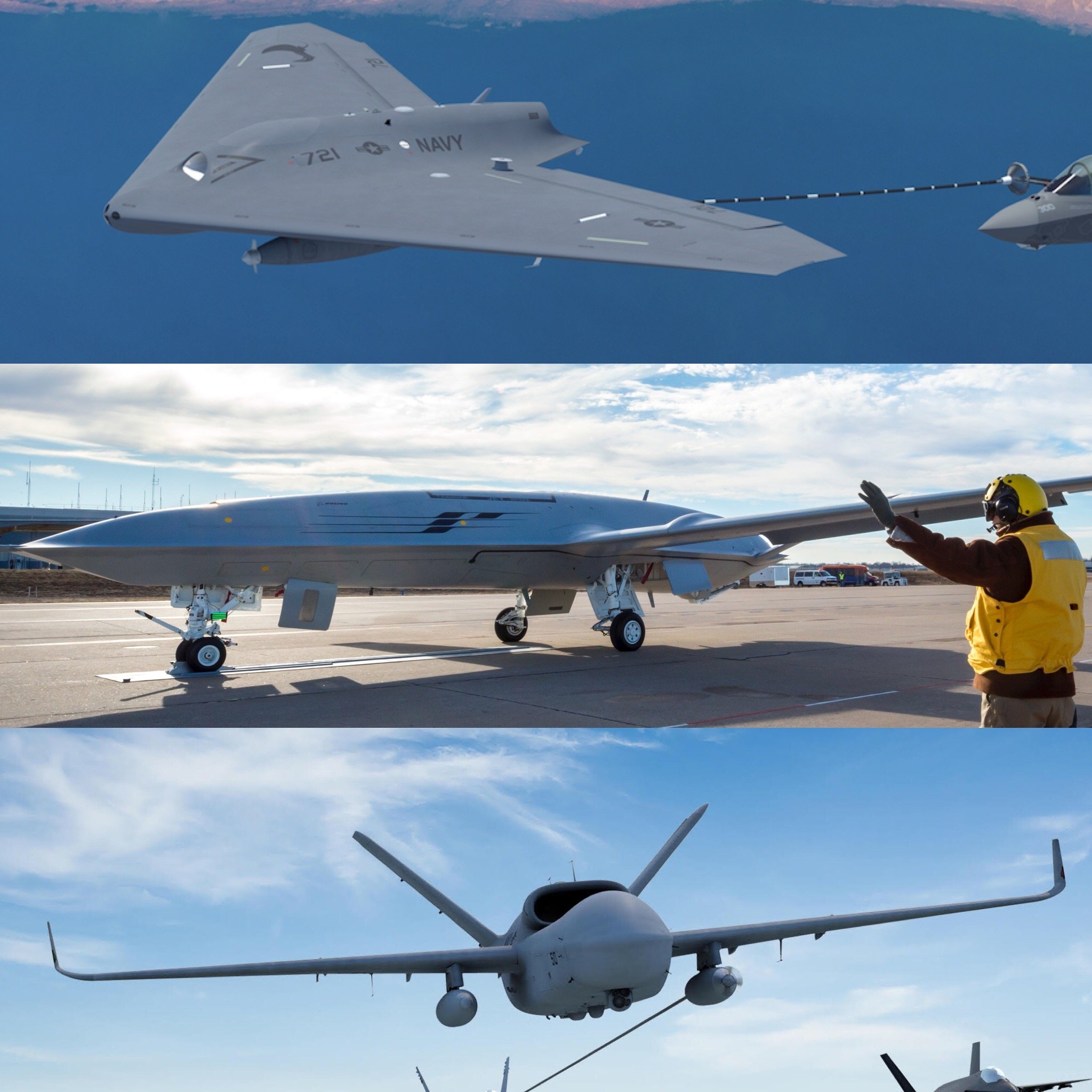Mq 25a Stingray - Lockheed Martin unveiled a concept for the Navy's MQ-25A Stingray unmanned aerial tanker in a series of images the company released to the USNI on Monday.
Skunk Works' response to a service request for a new carrier-based tanker is a tailless flying wing design that sets it apart from other competitors in the program.
Mq 25a Stingray

A series of four images shows a Lockheed Martin Stingray equipped with a single D-704 friendly tank on the left side of the fuselage centerline and a sensor array in the nose of the aircraft.
Video: Mq 25a Stingray Makes First Test Flight
The concept of flying wing is a break from other competitors. The Boeing and General Atomics Stingray designs — both revealed late last year — feature a wing-fuselage-tail design for the MQ-25A.
Rob Weiss, then head of Skunk Works, told reporters last year that the Navy's revisions to the requirements had pushed competitors away from flying wing designs that were inherently inefficient for the long-range anti-tank mission, such as wing-fuselage-tail-platforms . However, the company chose to retain the flying wing design, suggesting that the company envisions further growth in the MQ-25A operational concept to include missions that take advantage of the low observability of the tailless design .
The service's primary requirements are that the Stingray will carry about 15,000 pounds of carrier fuel, and Weiss said in March 2017, "It's defined as a tanker, so you don't want to go If your primary requirement is a tank is, with a tailless design,"
After the Navy narrowed its request to refueling only, Northrop Grumman, which had been expected to bid for the Stingray based on the X-47B tailless crank kite design, withdrew from the competition.
For The First Time, The Mq 25a Stingray Tanker Drone Is Visible With The Refueling Pod
In 2016, Weiss told reporters that if the Navy is interested in expanding the Stingray's capabilities beyond just a tanker, it should start with a basic design that can evolve into more missions that require low-observability characteristics.
"If you start with a vehicle shape that allows it to penetrate a combat environment, you can get gratitude at low cost without putting all the capabilities into that vehicle. ... You can do it at a lower cost, but stay on track to use that vehicle design to work in a penetrating environment," Weiss said in 2016.
The current competition for the Stingray is the latest in the Navy's 12-year effort to develop the first fixed-wing unmanned aircraft since it was phased out with the Air Force in joint UAV development in 2006.

Instead of creating a stealthy platform for deep strikes, the navy drafted requirements for the unmanned system to function as a carrier tanker at the direction of the Secretary of Defense. Currently, the F/A-18E/F Super Hornets meet the refueling requirements of the carrier air wing. 20 to 30 percent of Super Hornet types are needed for tank missions. The service prefers to use this free time for vacations and other missions.
Shaping A Maritime Kill Web Transition: The Case Of The Mq 25
The Navy allocated $719 million for the Stingray in fiscal year 2019 and plans to purchase the first four in 2023 and achieve initial operational capability on carrier decks in 2026. three MQ-25A Stingray unmanned tankers as part of a modification to a previously awarded contract.
The three MQ-25s covered by the contract options must be completed by August 2024, according to a contract notice released by the Pentagon on Thursday.
For more than a decade, the Navy has gone through an iterative development process to build the Navy's first unmanned tankers. In 2018, Boeing beat Lockheed Martin and General Atomics to an $805 million contract to produce the first four MQ-25As.
The Navy expects to integrate MQ-25 aircraft into the carrier's air wing for initial operational capabilities by 2024, according to a Navy fact sheet on the program.
New Navy Carrier Launched Drone Could Double Fighter Jet Range
The Navy's dream of an unmanned aerial tanker was born out of necessity. Currently, 20 to 30 percent of the carrier-based air wing's Super Hornet fleet is dedicated to aerial refueling operations. The introduction of the MQ-25A Stingray will free up those Super Hornets for strike missions. The MQ-25A is expected to deliver up to 15,000 pounds of fuel over 500 nautical miles.
In September, Boeing made the first flight of its T1 unmanned refueling aircraft. Boeing tested both the T1's control and the Navy's ability to speed up the long-stalled program.
Boeing first showed photos of the T1 prototype months before it won the contract award. The availability of the T1 allowed the Navy and Boeing to advance the tests well ahead of what would be typical for a new build in the development process.

The type of testing, which takes place in September, a year after contract award, typically does not begin until the first engineering development models (EDM) have been built. According to the Navy, the first EDM airframes with the MQ-25 program are expected to be ready for testing by the end of 2021.
First Ever Aerial Refueling Mq 25
Boeing previously announced plans to lift the T1 onto an aircraft and conduct flight control tests this year. Boeing plans to use the first EDM airframes for testing in 2021. The first carrier-based tests and sea trials are expected to take place in 2022 and 2023, the Navy previously said. The Boeing MQ-25 Stingray is an aerial refueling drone. Derived from the Carrier-Based Airborne Refueling System (CBARS) program, which emerged from the former Unmanned Carrier-Airborne Surveillance and Strike (UCLASS) program. The MQ-25 flew for the first time on September 19, 2019.
The United States Navy began trying to develop a carrier-based UAV in 2006. The original concept of UCLASS was for a stealth strike platform capable of countering air strikes. In 2012, lethality and strike requirements were reduced to create an intelligence, surveillance and reconnaissance (ISR) oriented aircraft that could be rapidly developed to conduct low-intensity counterterrorism missions.
On 1 February 2016, after delays over whether UCLASS would specialize in strike or ISR roles, it was announced that a major priority would be given to the production of a Super Hornet-sized carrier-based air tanker or a carrier-based air - tank system to air. (CBARS), "a little ISR" and some ability for communication relay and strike capabilities thrown in a future variant.
Pentagon made this program change to address the expected fighter jet shortage, likely by directing funds towards buying more F/A-18E/F Super Hornets and accelerating the purchase of the F-35C. Having CBARS as the first carrier-based UAV offers a less complex bridge to the future F / A-XX, it would become an unmanned strike platform. It also addresses the carrier's need for an organic refueling aircraft proposed for UCLASS since 2014, freeing up 20 to 30 percent of the Super Hornets to perform this mission more efficiently and cost-effectively than the F-35, V replacement. 22 Osprey and bringing the E-2D Hawkeye or the retired S-3 Viking back into service.
Boeing Mq 25 Stingray — Wikipédia
Four development contracts were awarded in 2016, a formal tender is expected in 2017, operational status is early to mid-2020s.
Contraadm. Michael Manazir suggested that three of these UAVs could fly with the F-35 for refueling and escort operations.
Vice Adm. Mike Shoemaker said the MQ-25 could extend the Super Hornet's 450 nmi (520 mi; 830 km) untanked combat radius to more than 700 nmi (810 mi; 1,300 km). The Navy's goal for the aircraft is to deliver a total of 15,000 lb (6,800 kg) of fuel to 4–6 aircraft over a range of 500 nmi (580 mi; 930 km).

The Navy issued its latest MQ-25 Stingray request for proposals in October 2017 to Lockheed Martin, Boeing, Northrop Grumman and General Atomics.
Boeing Wins Mq 25 Stingray Contract
Boeing secretly started building the wing-body tail in 2014, when the UCLASS program was terminated, and revived it for the CBARS mission.
On December 19, 2017, Boeing unveiled a prototype aircraft prototype that incorporates lessons learned from the Boeing Phantom Ray flying wing and its other unmanned aerial systems.
Boeing's MQ-25 design is not new to the refueling mission, but Boeing says it was designed for it.
Northrop Grumman announced on October 25, 2017 that it was withdrawing the X-47B from the MQ-25 competition, saying that the company could not run the program under the terms of the service's request for proposals.
Race To Be Us Navy's First Carrier Based Drone Heating Up
The company's departure signaled to some analysts that the Navy's requirements may favor wing-body-tail designs over the flying wings offered by Northrop Grumman and Lockheed Martin.
On August 30, 2018, the US Navy announced Boeing as the winner of the competition and awarded a $805 million development contract for four MQ-25A aircraft to be completed by August 2024.
An additional three test MQ-25As were ordered on April 2, 2020 for a total general order.

In late April 2019, the first MQ-25 test aircraft (T-1 or "Tail 1") flew from Boeing's maintenance facility at St. Louis Lambert International Airport across the Mississippi River to MidAmerica St. Louis Airport. Attached to Scott Air Force Base.
Mq 25 уперше дозаправив бойовий літак
After taxi tests, the Federal Aviation Administration certified the aircraft and granted airspace for takeoffs.
25a d2p3n104, 25a d024n104, mq 25a, mq 25 stingray, 25a d6p0n104, 25a d010n104, rssan 25a, 25a d2p3n114, 25a d010n114, 25a d017n104, pa 25a, 25a d4p0n104
0 Comments